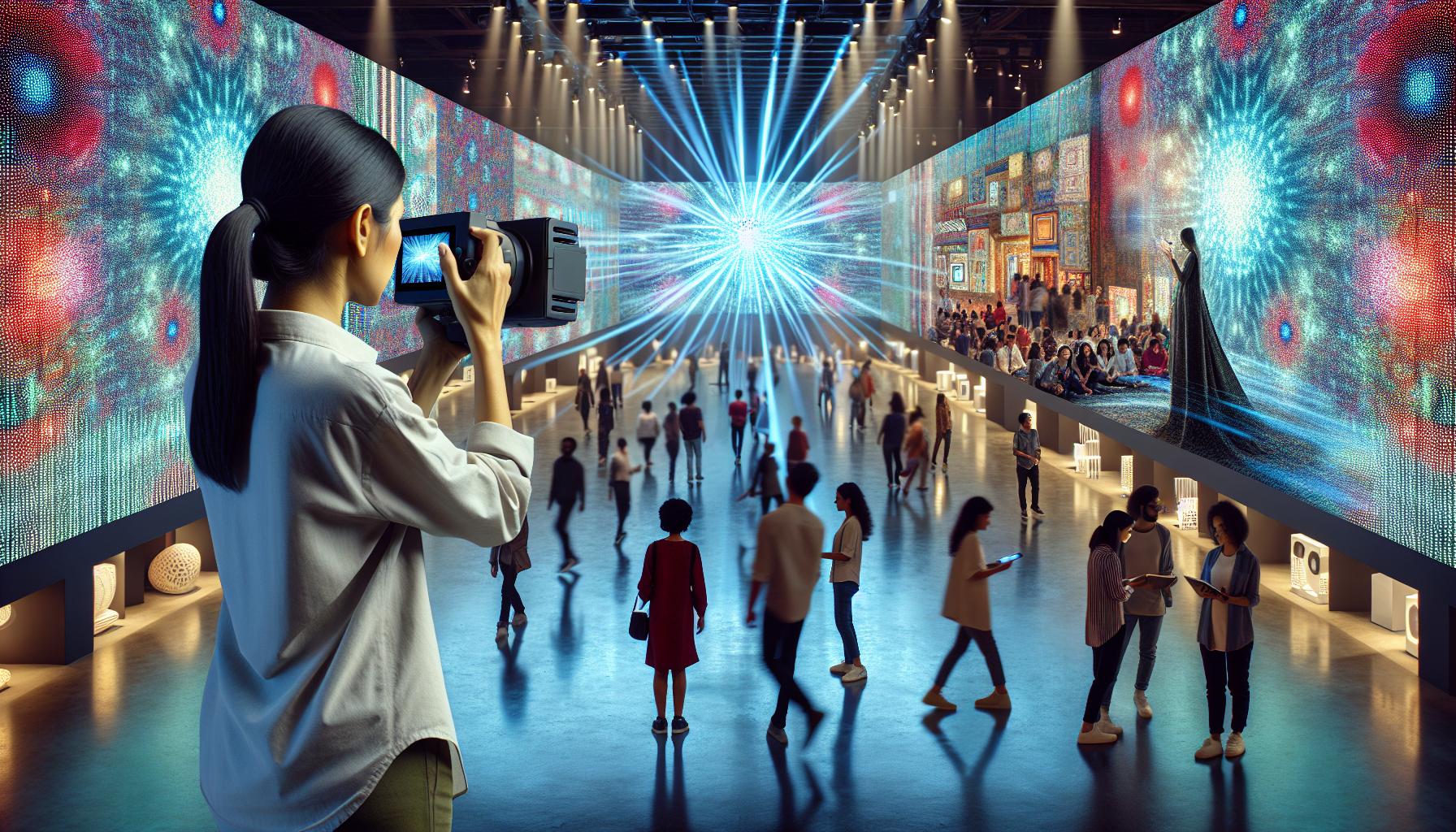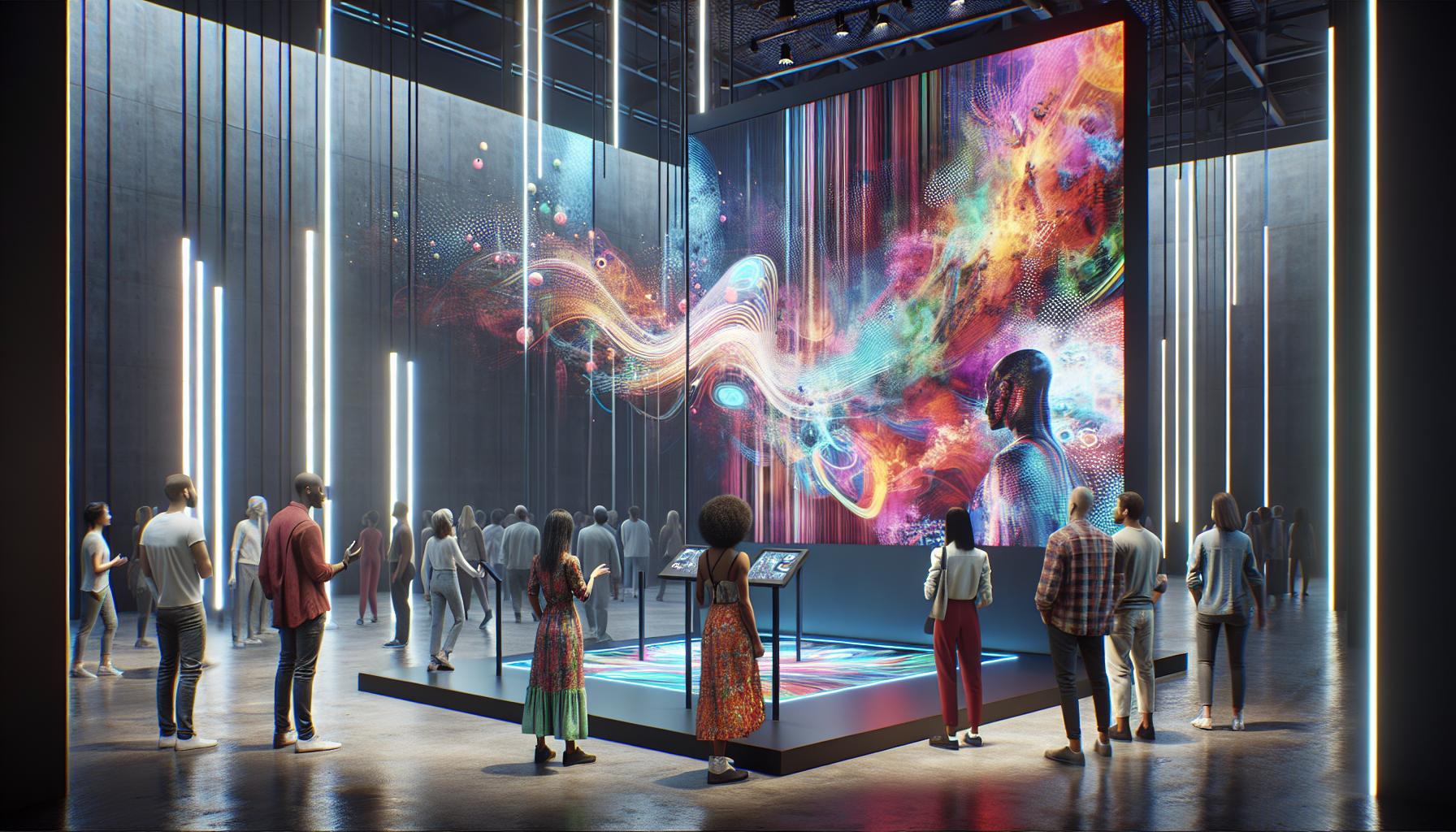Video installation art transforms ordinary spaces into immersive digital wonderlands where reality and imagination collide. Since its emergence in the 1960s this dynamic medium has revolutionized how audiences experience visual storytelling pushing the boundaries between technology and artistic expression.
In today’s digital age video installations have evolved from simple projected images to complex multi-channel experiences that engage all senses. Artists blend sound light movement and space to create environments that challenge viewers’ perceptions and invite them to become active participants rather than passive observers. From projection mapping on historic buildings to intimate gallery installations this versatile art form continues to captivate audiences worldwide while pushing the boundaries of what’s possible in contemporary art.
Video Installation Art
Video installation art combines video technology with spatial design to create immersive environments. This art form transforms physical spaces through the strategic placement of video displays, projections, sound systems and sculptural elements.
Key Elements of Video Installation
Video installations incorporate five essential components that define their artistic impact:
- Spatial Design: The calculated arrangement of screens, projectors and viewing spaces shapes the viewer’s physical journey through the installation
- Time-Based Media: Video content runs in specific sequences or loops, creating temporal experiences
- Sound Integration: Audio elements enhance the visual experience through strategically placed speakers or headphones
- Viewer Interaction: The audience becomes part of the artwork through their movement and engagement within the space
- Environmental Control: Lighting, room configuration and acoustic properties affect how viewers perceive the work
Historical Development and Origins
Video installation art emerged in the 1960s alongside the introduction of portable video recording equipment. Nam June Paik pioneered the medium in 1963 with his groundbreaking exhibition featuring manipulated television sets. The 1970s marked significant developments:
- Bruce Nauman created corridor installations with closed-circuit cameras
- Peter Campus integrated live video feeds with delayed projections
- Bill Viola established new techniques for multi-channel video presentations
- Vito Acconci combined performance art with video documentation
These early experiments established video installation as a distinct artistic medium that continues to evolve with advancing technology.
Technical Components of Video Installations

Video installation art relies on specific technical elements to create immersive experiences. These components form the foundation of successful installations, enabling artists to achieve their creative vision.
Display Technologies and Equipment
Video installations incorporate multiple display technologies to present visual content. Professional-grade projectors deliver high-resolution images onto various surfaces such as walls, floors or custom screens. LED displays offer vibrant colors in well-lit environments while plasma screens provide deep blacks for darker spaces. Media players, including digital video servers sync multiple channels of content across displays. Essential equipment includes:
- Signal processors for image scaling adjustments
- Audio amplifiers paired with strategically placed speakers
- Control systems for automated playback sequences
- Video switchers to manage multiple input sources
- Mounting hardware customized for specific display configurations
- Ceiling height requirements for projection throw distances
- Acoustic treatments to control sound reflection patterns
- Traffic flow patterns that guide viewer movement
- Power distribution systems to support equipment placement
- Climate control systems to maintain equipment operating temperatures
- Sight lines that determine optimal viewing positions
- Light-blocking solutions for managing ambient illumination
Notable Video Installation Artists

Video installation artists transform spaces into immersive experiences through their innovative use of technology and artistic vision. Their contributions continue to shape this dynamic medium across different decades and artistic movements.
Early Pioneers
Nam June Paik laid the foundation for video art in 1963 with his groundbreaking exhibition “Exposition of Music – Electronic Television.” His installation “TV Buddha” (1974) explored the relationship between technology and spirituality. Wolf Vostell created “6 TV Dé-coll/age” in 1963, incorporating television sets into environmental installations. Bill Viola emerged in the 1970s with emotionally charged works like “The Reflecting Pool” (1977-79). Peter Campus pioneered interactive video installations with “Interface” (1972), using closed-circuit systems to engage viewers. Mary Lucier developed “Dawn Burn” (1975), examining the effects of light on video camera tubes through time-based installations.
Contemporary Masters
Tony Oursler creates multimedia installations combining video projections with sculptural elements, as seen in “The Influence Machine” (2000). Pipilotti Rist transforms architectural spaces through large-scale projections in works like “Pour Your Body Out” (2008). Doug Aitken produces multi-channel video environments, exemplified by “Sleepwalkers” (2007) projected on MoMA’s exterior walls. Isaac Julien crafts narrative-driven installations across multiple screens, including “Ten Thousand Waves” (2010). Jennifer Steinkamp specializes in digital animations that alter spatial perception, demonstrated in her “Madame Curie” (2011) series. Matthew Barney integrates video installations within larger artistic frameworks through his “Cremaster Cycle” (1994-2002).
Common Themes and Artistic Approaches

Video installation artists explore recurring themes through diverse conceptual frameworks, creating immersive experiences that challenge viewer perception. Their artistic approaches combine technical innovation with profound narrative elements to transform spaces into dynamic environments.
Narrative and Storytelling
Video installations employ non-linear storytelling techniques to explore personal identity, collective memory, social justice themes, environmental concerns. Artists layer multiple video channels to create fragmented narratives that viewers piece together through their individual experiences. The manipulation of time through slow motion, loops, repetition enhances the storytelling impact, as seen in Bill Viola’s “The Crossing” which examines human consciousness through parallel sequences of fire and water. Documentary footage, archival materials, original recordings combine to address cultural histories, displacement, memory politics.
Interactive Elements
Motion sensors detect viewer movements to trigger specific video sequences in responsive installations. Touch screens enable direct manipulation of digital content, creating personalized viewing experiences. Artists incorporate real-time data feeds that transform environmental inputs into visual displays. Proximity-based sound activation adds depth to spatial narratives, responding to audience location within the installation space. Camera-based tracking systems allow viewers to become part of the artwork, their silhouettes integrated into projected imagery. Interactive elements transform passive observers into active participants who shape the evolving artwork through their presence and actions.
Impact on Contemporary Art
Video installation art transforms traditional art spaces into dynamic environments that challenge conventional artistic boundaries. This medium’s integration of technology with spatial design revolutionizes how audiences experience contemporary art.
Museum and Gallery Presentations
Museums dedicate entire wings to video installations, reflecting their significance in modern art collections. Major institutions like MoMA, Tate Modern, and Centre Pompidou showcase large-scale video installations that attract diverse audiences. Galleries adapt their spaces with specialized lighting systems, sound-dampening materials, and flexible viewing areas to accommodate video art presentations. Custom-built environments enable curators to present works that merge architectural elements with projected imagery, creating site-specific experiences that redefine exhibition spaces.
Digital Age Influence
Digital technologies expand video installation possibilities through 4K resolution displays, artificial intelligence integration, and virtual reality components. Social media platforms amplify the reach of video installations, connecting artists with global audiences through shared experiences. Mobile devices enable artists to incorporate augmented reality elements, extending installations beyond physical boundaries. Contemporary video artists leverage cloud computing, real-time data streams, and interactive software to create responsive environments that evolve with viewer participation. Digital tools facilitate complex multi-channel synchronization, enabling artists to orchestrate precisely timed audiovisual experiences across multiple screens.
Video installation art stands as a transformative force in contemporary art that continues to push creative boundaries. Through technological innovation and artistic vision it creates immersive experiences that challenge traditional art viewing paradigms.
The fusion of digital technology spatial design and interactive elements has elevated this medium beyond simple video presentations. As museums galleries and public spaces increasingly embrace video installations their influence on art culture and society grows stronger.
The future of video installation art looks promising as emerging technologies and evolving artistic approaches create new possibilities for expression and engagement. This dynamic medium remains at the forefront of artistic innovation bridging the gap between technology and human experience.



